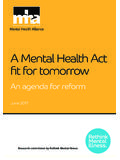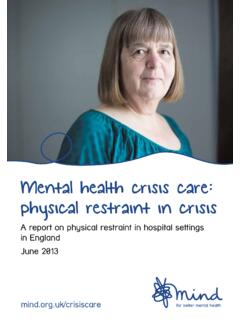Transcription of The Mental Health Act 2007: a review of its …
1 The Mental Health Act 2007 : a review of its implementationMay 20122 The Mental Health Act 2007 ContentsAcknowledgements 2 Summary 3 Introduction 31. Community treatment orders (CTOs) 42. The deprivation of liberty 9 safeguards (DoLS) 3. Independent Mental Health 14 advocacy (IMHA) 4. Children and young people 165. Race equality 176. Section 136 places of safety 197. Regulation (the Care Quality 20 Commission)8. The Mental Health Measure 22 in WalesConclusions 23 References 25 AcknowledgementsWritten by Catherine Jackson and members of the Mental Health Alliance. With thanks to Simon Lawton-Smith, Roger Hargreaves, Rezina Hakim, Marcel Vige, Andy Bell, Rowena Daw, Paula Lavis, Bill Walden-Jones and Alison Mental Health Act 2007 3 SummaryThe Mental Health Act 2007 introduced some positive changes, in particular for children and young people and through the introduction of Independent Mental Health Advocacy.
2 Where people have made the Deprivation of Liberty Safeguards (DoLS) work they have improved people s lives. However this period has seen a continuing rise in the number of people under compulsion, with more people going onto community treatment orders than coming off them. Ethnic inequalities among detained patients are further magnified in the use of community treatment orders. The rights people technically have are not being consistently upheld. For example, people are denied their rights if Independent Mental Health Advocacy (IMHA) services are not commissioned adequately or hospital staff do not inform patients about the service. The DoLS scheme is too flawed to assure the rights of people who lack capacity and there are extreme variations in its new NHS structures and organisations are developed, it is essential that outcomes for people subject to the Mental Health Act are properly captured and that implementation of the Mental Health strategy No Health without Mental Health fully includes their rights and Mental Health Alliance will continue to monitor implementation of the Act and encourage continuing discussion about legislation that is based on impaired decision-making1.
3 Our immediate priorities are: to feed into the Government s five year review of the legislation to draw up recommendations for an improved scheme to ensure the effectiveness of the Deprivation of Liberty Safeguards and to address continuing entrenched race Mental Health Alliance is a unique coalition of 75 organisations from across the Mental Health spectrum and beyond. We came together in 1999 to work for humane and effective Mental Health The Mental Health Alliance view on impaired decision-making is not shared by Mental Health Act 2007 introduced a number of significant changes to the Mental Health Act 1983, with far-reaching implications for Mental Health service users and their families and carers. Starting with the 2000 White Paper and continuing through the 2002 and 2004 draft Mental Health Bills, which were subsequently dropped and replaced by the 2006 Mental Health Bill, the Mental Health Alliance campaigned vociferously for truly rights-based legislation that would ensure people with Mental Health problems were not discriminated against in comparison with people needing treatment for physical we wanted was a completely new Act built on the principle that people should only be detained and treated without their consent if their capacity to make decisions on their own behalf was impaired and they were at risk to themselves or to Mental Health Act that was finally passed by Parliament in July 2007 included some measures that we supported, and several that we did not.
4 Since that time, the Alliance has continued to monitor implementation of the Act, to recognise successes and to flag up concerns on behalf of people affected by the Act. An overarching concern that we will continue to monitor is the increase in the use of compulsory powers (including the use of community treatment orders (CTOs)) for the treatment of people with Mental illness, as expressed in the figures of those detained in England and Wales, which have continued to rise. Information and data collected indicates that the number of people subject to detention under the powers of the Act has risen each year since 2000 and they are an increasing proportion of the inpatient population. In 2009/10, the Mental Health Act was used more than ever before. In England there were 45,755 detentions during the year, that is people admitted under detention or detained while in hospital. In Wales during 2009 10, 1,453 people were detained in hospital under the powers of the Mental Health Act (CQC and Health Inspectorate Reports).
5 There were 16,647 people detained in hospital under the Mental Health Act at the end of 2010/11. This is a 4 The Mental Health Act 2007slight increase since the previous reporting period and represents a continuing pattern of increase since 2007 /08 although the rate of increase appears to be slowing. However in combination with the number of people on CTOs at 31 March 2011, it is apparent that increasing numbers of people are being subject to restrictions under the Mental Health Act (NHS Information Centre, October 2011). This report reviews specific areas of concern following the Act s Community treatment orders (CTOs)Key issues Higher use of CTOs than expected Disproportionate use of CTOs for people from BME communities Inappropriate use of CTOs Lack of adequate community support for patients on CTOs Serious delays in obtaining second opinions to authorise treatment A concurrent increase in the number of detained patientsCommunity treatment orders (CTOs) were introduced under the Mental Health Act 2007 with the explicit aim to improve the care and support of some people with severe Mental Health problems in the community following discharge from psychiatric hospital.
6 CTOs give clinicians powers to recall patients following their discharge from detention in hospital if they relapse or have a change of circumstances and pose a high risk to themselves or others on account of their Mental disorder (Code of Practice ). Patients can only be placed on a CTO if they are at the time detained in hospital under a s3 or s37 treatment order of the Mental Health Act placed on a CTO are given what is known as supervised community treatment . This means patients can, at their clinicians discretion based on CTO criteria, be returned to hospital for compulsory treatment for their Mental disorder if they stop taking their medication and/or disengage with services. They can be recalled for treatment for up to 72 hours, after which they must return to the community, or the CTO may be revoked, which means they will be placed on a new treatment order for up to 6 set of criteria govern the use of CTOs.
7 They may be used where: the patient is suffering from a Mental disorder such that they need medical treatmentThe Mental Health Act 2007 5 it is necessary for the patient s Health or safety or the protection of others that they should receive such treatment treatment can be provided without the patient being detained in hospital, provided there are powers to recall the patient to hospital for medical treatment and appropriate medical treatment is term medical treatment in the Act has a broad meaning that includes nursing, care, habilitation and rehabilitation (learning new skills or relearning old skills).Importantly, CTOs do not give clinicians powers to force patients to take medication outside a hospital or clinic setting. The clinician may only enforce treatment by recalling the person to hospital if they think this is necessary. However being subject to recall to hospital detention is itself a form of compulsion.
8 The Alliance has conducted its own research into the implementation and use of the new powers, including surveys of psychiatrists and of service users and carers. The Care Quality Commission (CQC) has also published statistical data on the use of the new powers in its annual reports Monitoring the use of the Mental Health Act for 2009/10 and 2010/11 and the NHS Information Centre published (incomplete) data in June 2011 showing the numbers of people subject to a CTO in England. Similarly in Wales, the Health Inspectorate has published statistical data for the use of CTOs in Wales. Together these data suggest a number of areas of serious and continuing concern. Higher use of CTOs than expectedThe Department of Health predicted that some 400 600 patients would be placed on CTOs in the first fact, a total of 6,237 CTOs were made in England in the first 17 months of their implementation , between November 2008 and end of March 2010 (NHS Information Centre, 2010) an average of about 350 each month.
9 As at March 2011, some 4,291 people living in the community in England were recorded as being subject to a CTO (though this data was incomplete) (NHS Information Centre, 2011b).More people are being given CTOs than are being discharged from them, resulting in a gradual accumulation of patients under community compulsion. More than two thirds (68 per cent) of CTOs imposed in England between November 2008 and March 2010 were still in place at the end of this period. Of the 32 per cent that were released from their CTO, roughly half were returned to detention in hospital and half were discharged from any section (NHS Information Centre, 2010). In Wales, during 2009 10, 261 people were made the subject of a CTO, with a total of 426 orders being issued in the 17 months since their introduction in November 2008. This was reported by the Health Inspectorate Wales as being far higher than expected. In Wales in 2010 11 there were 233 patients subject to CTOs, among which there were 87 recalls to hospital, 74 revocations and 78 Disproportionate use of CTOs among some BME groupsNational statistics (NHS Information Centre 2011b, Care Quality Commission 2011) show that CTOs are being used more frequently with some black and minority ethnic communities (particularly South Asian and Black groups).
10 At the end of March 2011, per cent of those on a CTO were Black or Black British. Black and White/Black Mixed groups already experience disproportionate use of coercion and detention under the Mental Health Act 1983 (see the section 5, Race Equality).Overall, the data indicate that use of CTOs is magnifying an existing disproportionate use of coercion in the treatment of black people. This raises major concerns about race equality and discrimination Inappropriate use of CTOsCTOs are being used mainly with patients who are on long-term antipsychotic maintenance medication (81 per cent according to the CQC (Care Quality Commission (2010)) for schizophrenia or other psychoses. This is the group for whom CTOs were primarily designed, on the grounds that this group was at significant risk of relapse and a danger to themselves or others, following discharge from hospital back into the community. However, data suggest that nearly a third (30 per cent) of patients 6 The Mental Health Act 2007on CTOs have no history of non-compliance with treatment or of disengagement with services.)










